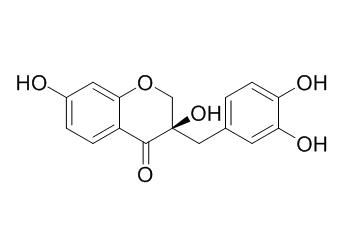Sappanone B
Sappanone B has vasorelaxation effects, it exhibits an acute relaxation either in endothelium-intact or endothelium-denuded rings in a concentration-dependent manner. Sappanone B also exhibits moderate to weak activity against methicillin-susceptible S. aureus (MSSA) and other standard strains by MICs/MBCs ranged from 32/64 to >1024/>1024 ug/ml.
Inquire / Order:
manager@chemfaces.com
Technical Inquiries:
service@chemfaces.com
Tel:
+86-27-84237783
Fax:
+86-27-84254680
Address:
1 Building, No. 83, CheCheng Rd., Wuhan Economic and Technological Development Zone, Wuhan, Hubei 430056, PRC
Providing storage is as stated on the product vial and the vial is kept tightly sealed, the product can be stored for up to
24 months(2-8C).
Wherever possible, you should prepare and use solutions on the same day. However, if you need to make up stock solutions in advance, we recommend that you store the solution as aliquots in tightly sealed vials at -20C. Generally, these will be useable for up to two weeks. Before use, and prior to opening the vial we recommend that you allow your product to equilibrate to room temperature for at least 1 hour.
Need more advice on solubility, usage and handling? Please email to: service@chemfaces.com
The packaging of the product may have turned upside down during transportation, resulting in the natural compounds adhering to the neck or cap of the vial. take the vial out of its packaging and gently shake to let the compounds fall to the bottom of the vial. for liquid products, centrifuge at 200-500 RPM to gather the liquid at the bottom of the vial. try to avoid loss or contamination during handling.
Proc Biol Sci.2024, 291(2015):20232578.
Int J Mol Sci.202, 25(17):9246.
Biomed Pharmacother.2023, 162:114617.
Ann Transl Med.2019, 7(23):731
Exp Parasitol.2017, 183:160-166
J Biotechnol.2020, 318:10-19.
Heliyon.2022, 8(12):e12031.
Nat Commun.2019, 10(1):2745
Pharmacognosy Journal2019, 11(2): 369-373
Research Square2021, 10.21203.
Related and Featured Products
Phytomedicine. 2014 Jun 15;21(7):936-41.
Synergy of aminoglycoside antibiotics by 3-Benzylchroman derivatives from the Chinese drug Caesalpinia sappan against clinical methicillin-resistant Staphylococcus aureus (MRSA).[Pubmed:
24703330]
METHODS AND RESULTS:
The in vitro antimicrobial activities of three 3-Benzylchroman derivatives, i.e. Brazilin (1), Brazilein (2) and Sappanone B (3) from Caesalpinia sappan L. (Leguminosae) were assayed, which mainly dealt with synergistic evaluation of aminoglycoside and other type of antibiotics against methicillin-resistant Staphylococcus aureus (MRSA) by the three compounds through the Chequerboard and Time-kill curve methods.
The results showed that Compounds 1-3 alone exhibited moderate to weak activity against methicillin-susceptible S. aureus (MSSA) and other standard strains by MICs/MBCs ranged from 32/64 to >1024/>1024 μg/ml, with the order of activity as 1>2>3. Chequerboard method showed significant anti-MRSA synergy of 1/Aminoglycosides (Gentamicin, Amikacin, Etimicin and Streptomycin) combinations with (FICIs)50 at 0.375-0.5. The combined (MICs)50 values (μg/ml) reduced from 32-128/16-64 to 4-8/4-16, respectively.
The percent of reduction by MICs ranged from 50% to 87.5%, with a maximum of 93.8% (1/16 of the alone MIC). Combinations of 2 and 3 with Aminoglycosides and the other antibiotics showed less potency of synergy.
Zhongguo Zhong Yao Za Zhi. 2009 Mar;34(6):731-4.
Vasorelaxation effects of homoisoflavonoids from Caesalpinia sappan in rat thoracic aortic rings.[Pubmed:
19624017]
To identify and elucidate the vasorelaxant activity of homoisoflavonoids, the main chemical components from Lignum Sappan (the stems of Caesalpinia sappan), in isolated rat thoracic aortic rings pre-contracted with phenylephrine (PE, 1 micromol x L(-1)) and KCl (60 mmol x L(-1)).
METHODS AND RESULTS:
The tension of rat thoracic aorta rings was used to evaluated the vasorelaxant activities of four homoisoflavonoids, brazlin (1), (E)-3-(3,4-dihydroxybenzylidene)-7-hydroxychroman-4-one (2), Sappanone B (3), 3-deoxySappanone B (4).Cumulative addition of homoisoflavonoids (2, 3 and 4) (50-1000 micromol x L(-1)) exhibited an acute relaxation either in endothelium-intact or endothelium-denuded rings in a concentration-dependent manner. However, this relaxation was significantly inhibited in endothelium-denuded condition and in the presence of endothelial nitric oxide synthase (eNOS) inhibitor, N(W)-nitro-L-arginine methyl ester (L-NNA, 100 micromol x L(-1)), and a soluble guanylate cylcase (sGC) inhibitor, methylene blue (MB, 10 micromol x L(-1)) when addition of variation homoisoflavonoids brazlin (1) (50-1000 micromol x L(-1)).
CONCLUSIONS:
These results indicate that normo-homoisoflavonoids (2, 3 and 4) from Caesalpinia sappan mediates endothelium-independent vasodilator action in rat thoracic aortic rings, while the variation homoisoflavonoids brazlin elicits endothelium-dependent relaxation might via nitric oxide (NO)-cGMP pathway. This research could explain the pharmacological activities of homoisoflavonoids to a certain degree.



